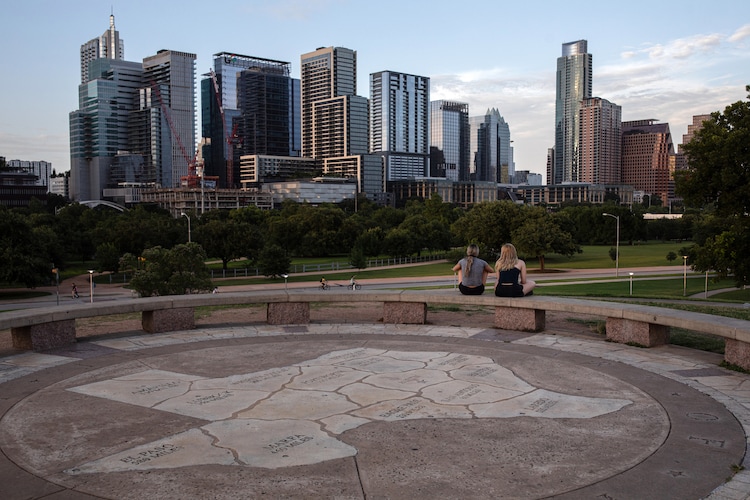Salt Lake City is “just like Austin” but a handful of years behind, a local developer recently told the New York Times.
Others describe a formerly “stodgy” city now becoming vibrant amid Utah’s economic boom and a growing interest in recreation.
The Times’ story may presume that Salt Lake City could be another Austin. Which may or may not be desirable. But by the numbers, how does Salt Lake City really compare to Austin?
Here’s what the data show about population, demographics, economics and culture.

(Tamir Kalifa | The New York Times) The skyline of Austin, Texas, June 26, 2020. A recent Times story included a source who believes Salt Lake City is like Austin, but a few years behind.
Population: Austin larger, more diverse than Salt Lake City
Austin has nearly five times as many people and is literally larger than Salt Lake City — 319.94 square miles compared to 110.34, according to the U.S. Census Bureau.
It also packs in more people per square mile. American Community Survey data shows around 3,006 people live in each square mile of the Lone Star State’s capital, while the capital of the Beehive State boasts just 1,800 or so people per square mile.
An analysis by John Burns Research and Consulting based on postal address change forms shows Austin still has more people moving in and out while Salt Lake City is seeing big out-migration.
A report from the Kem C. Gardner Institute found Salt Lake County gained 1,828 people a year from other states between 2015 and 2019 but lost 1,947 people to other Utah counties a year in that same time frame.
That’s a net loss of about 119 people through migration per year, though the county did still gain population overall.
Austin’s population is also more diverse — the city is about 66% white, compared to Salt Lake City at nearly 73% white. Austin specifically has a larger portion of people identifying as Black, Asian, Multiracial and Hispanic or Latino.
Salt Lake City does edge out Austin in its American Indian or Alaskan Native and Native Hawaiian populations. But Austin has a higher foreign-born population with 18.5% compared to Salt Lake City’s 15.3%
Both cities are generally younger than the national average, though Austin is home to slightly more minors and Salt Lake City has a higher population of seniors as Utah ages.
Economics: Salaries, housing prices higher in Austin
Salt Lake City edges out Austin for people looking for cheaper housing and a shorter commute.
Austin’s median home sale price is $571,500 according to Redfin, and the city’s median rent for a two-bedroom apartment is $1,763 according to Apartment List. That’s about 4% more and 24% more than in Salt Lake City, respectively.
Living in Salt Lake City also saves people about four minutes commuting each way, according to Census Bureau data.
(Francisco Kjolseth | The Salt Lake Tribune) Traffic moves along I-15 in Salt Lake City on Thursday, September 3, 2020. Salt Lakers may complain about heavy traffic, but research shows they spend 4% less commuting time than residents of Austin, Texas.
Salt Lake City’s unemployment rate is lower, too, at 2.7% compared to 3.8%, according to the Bureau of Labor Statistics.
But people living in Austin are more likely to have a higher salary and at least a bachelor’s degree, and they’re less likely to live in poverty.
Nearly 60% of Austin’s residents who are 25 or older have at least a bachelor’s degree, compared to about 51% of Salt Lake City residents, Census Bureau data shows.
The median household income is $78,965 in Austin, about 20% higher than Salt Lake City’s median income of $65,880.
And just 12.5% of Austin residents live below the poverty line, compared to 14.7% of Salt Lake City residents.
Culture: More breweries per capita, similar queer population
While a Utahn in real estate development contended the odds of finding a coffee shop or brewpub in the early 2000s were basically zero, Salt Lake City isn’t as dull as some Times sources assume.
Salt Lake City has more breweries per person, with 6.9 per 100,000 people according to Building Salt Lake.
In comparison, Austin has 4.7 breweries per 100,000 people.
(Francisco Kjolseth | The Salt Lake Tribune) People enjoy an evening in downtown Salt Lake City on Tuesday, May 30, 2023. And what's that? Salt Lake has more breweries per person than Austin, Texas.
And while Salt Lake City is perhaps best known for being a gateway to the “greatest snow on Earth” and the global headquarters of The Church of Jesus Christ of Latter-day Saints, it’s also one of America’s queerest cities.
While people identifying as LGBTQ say there’s a lot of work to do to make Utah more inclusive, the data shows Salt Lake City itself is pretty queer.
About 5% of the city’s population identifies as LGBTQ, according to the Williams Institute at the UCLA School of Law. That’s not much lower than Austin’s 5.9%.
In short, Salt Lake City might have to gain in some ways and give up ground in others to become another Austin.
It also would have to gain enough humidity that the air feels like hot soup. Takers?
Megan Banta is The Salt Lake Tribune’s data enterprise reporter, a philanthropically supported position. The Tribune retains control over all editorial decisions.
Editor’s note • This story is available to Salt Lake Tribune subscribers only. Thank you for supporting local journalism.
Editor’s note • This story is available to Salt Lake Tribune subscribers only. Thank you for supporting local journalism.






